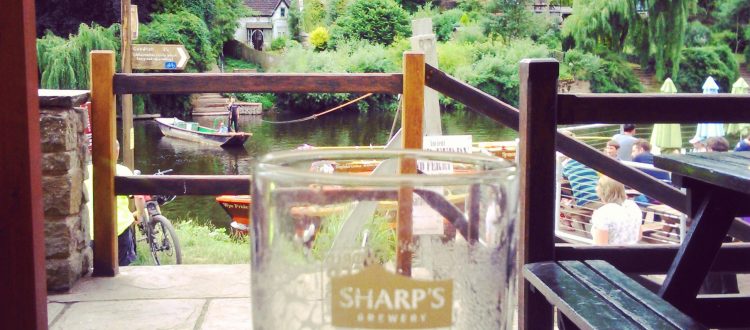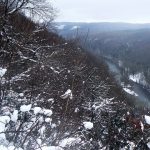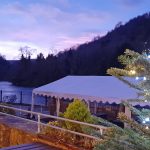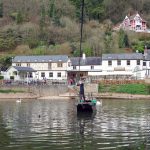Symonds Yat & Wye Valley Walks
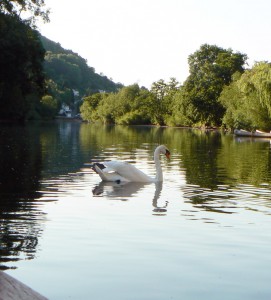 Symonds Yat is an ideal place for a relaxing walk, or an invigorating hike. There are endless miles of forest and tracks to explore, and if you add the nearby Forest of Dean, you could literally spend weeks navigating your way, from hamlet to parish, without encountering anything more than quiet woodland and ancient British wilderness.
Symonds Yat is an ideal place for a relaxing walk, or an invigorating hike. There are endless miles of forest and tracks to explore, and if you add the nearby Forest of Dean, you could literally spend weeks navigating your way, from hamlet to parish, without encountering anything more than quiet woodland and ancient British wilderness.
The area of Symonds Yat lies within the borders of Herefordshire and Gloucestershire. Many people mistakenly think that Symonds Yat is in Wales, it isn’t, however it is very near the border of Monmouthshire and you can easily wander into Wales when exploring Symonds Yat without ever knowing.
Robert Symonds gave his name to Symonds Yat during the 17th-century. Symonds was a sheriff of Herefordshire and the word “yat” is an old word for a gate or pass. Today the area is a mixture of private land and woodland which is cared for mainly by the Forestry Commission.
Fallow deer, barn owls and peregrine falcons are often seen or heard, and very occasionally wild boar can be seen too. Badgers are common, though rarely seen, and stoats, weasels, foxes, woodmice, bank voles and even dormice are present. Many species of butterfly, hornets, bats and European cave spiders also make their home in the woods and caves.
We actually have our own Wye Valley Walking Guide which can be downloaded as a pdf here or pick up a copy at the pub.
Here are a few pointers when exploring Symonds Yat and the surrounding Wye Valley by foot:
Wye Valley Walk – Monmouth to Ross on Wye
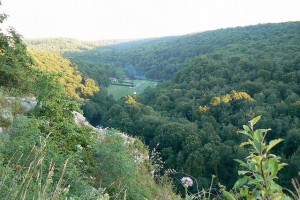 The Wye Valley Walk is a 136 mile (218km) hike of startling contrasts from ravine gorge cloaked in woodland, through meadow and orchard, to rugged and remote uplands.
The Wye Valley Walk is a 136 mile (218km) hike of startling contrasts from ravine gorge cloaked in woodland, through meadow and orchard, to rugged and remote uplands.
The walk begins many miles away up stream of Symonds Yat and follows the Wye through the battle scarred Anglo-Welsh borders to where it pours in rocky cascades from its mountain source.
If you are visiting for a few days and wish to complete a small part of this walk, you may want to consider the Monmouth to Ross section.
Starting in open fields this is an almost entirely level stretch of riverside walking following the meanders of the Wye and passing under the spectacular limestone cliffs and woodlands of the upper Wye gorge.
Old Hand Ferrie, Wye Valley Walk
The walk passes through Symonds Yat with its riverside pubs, boat trips, rock climbers, cavers and canoeists.
Then, at just over half way to Ross, there’s an abrupt change of pace, the path climbing through steeply wooded hills and narrow valleys around Leys Hill and Howle Hill, before dropping into Ross from the heights of Chase Hill.
The opposite direction from Monmouth will take you to the beautiful surroundings of Tintern Abbey with plenty more exploring to do, such as the Devil’s Pulpit.
Distance: 17-18 miles (27-29km). High point: 196m (647ft) Chase Wood.
Goodrich Castle, Coppett Hill & Welsh Bicknor
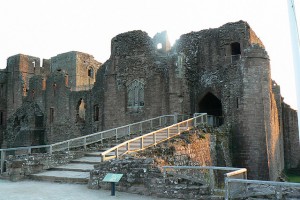 For a really historic and interesting day out, this route takes in the impressive grandeur of Goodrich Castle and Coppett Hill. Parts of this route are also included in the Wye Valley Walk.
For a really historic and interesting day out, this route takes in the impressive grandeur of Goodrich Castle and Coppett Hill. Parts of this route are also included in the Wye Valley Walk.
Primarily a Norman medieval castle, Goodrich Castle became the scene of one of the most desperate sieges during the English Civil War in the 1640s, which saw the rival factions of Parliament and the king vie for power across England. The Roaring Meg mortar used against the castle in March 1646 sits in the main courtyard next to a deep well.
There are various ghost tales many of which involve the White Lady who is said to have drowned with her lover before the final assault of the castle during the English Civil War.
The picturesque ruins of the castle inspired many artists’ work, including David Cox, who produced beautiful watercolours in 1815. It was also captured in poem by William Wordsworth when he met a little cottage girl in October 1793 and subsequently wrote the fascinating and mysterious poem ‘We Are Seven‘.
Coppett Hill is home to fallow deer, adders, many species of butterfly and stunning views. The top of the hill has been declared a Nature reserve.
At the foot of the hill (Welsh Bicknor) is a Norman style church which is no longer open, find the ancient grave stone of the boy who drowned- A reminder about the perils of the Wye. If you follow the river bank up towards Symonds Yat for half a mile or so, you will find the old iron girder rail bridge which now carries the Wye Valley Walk across the river. If you head inwards toward the hill you can find the disused rail tunnel (it is not advisable to wander inside).
The route is explained on The AA Website as Beside the River Wye and up Coppet Hill.
The Little Doward and Great Doward
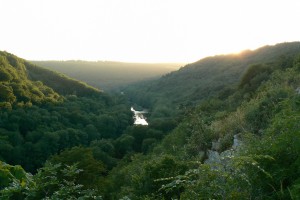 Mooching around Symonds Yat West is a day or two in itself. The hamlets of the Little, and Great, Doward make up a substantial part of the Yat. The area is part of South Herefordshire and it sits on the Monmouthshire border.
Mooching around Symonds Yat West is a day or two in itself. The hamlets of the Little, and Great, Doward make up a substantial part of the Yat. The area is part of South Herefordshire and it sits on the Monmouthshire border.
The Great Doward consists of extensive stratified limestone mountains with large deposits of rich iron-ore. The Yat Gorge was mined for iron ore and remains of a smelting works are located down stream of the Symonds Yat Rapids.
The ironworks at New Weir date from the 1590s and closed in 1798. There is also a limekiln upstream of the Saracens which was used from 1700s onwards making lime by heating limestone to over 1000°C. The lime was used in building for mortar, plaster and limewash; in a variety of industrial processes and in agriculture as a soil improver. This particular lime kiln was out of use by 1850.
To the west, the area is woody with wild elevations, an Area of Outstanding Natural Beauty (AONB). Little Doward hosts a British hill fort which seems to have been refortified in the post-Roman era. In Iron Age times the forts on the Great Doward and the Yat Rock provided secure, defensible settlements for the local residents.
Scattered throughout the large-scale Yew, Ash and Beech forests exist an extensive network or caves, most of which require professional caving guides. Some were mines, long since abandoned, and others such as King Arthur’s Cave are natural.
King Arthur’s Cave and the Wye Valley have been the site of intriguing archaeological digs. Bones from hyenas, sabre-toothed cats, woolf, reindeer, lion, brown bear, red deer, rhinoceros, irish elk, and a Mammoth have been found. Human inhabitation can be traced back to 12,000 years ago with findings of their tools and clothes. It is a designated a site of Special Scientific Interest.
A popular feature of Symonds Yat is the hand ferrie. These ferries have played an important role in local life for many centuries. In 1800 there were 25 hand ferries between Ross and Chepstow, today there are just two. The Saracens ferrie runs throughout the year.
The Biblins suspension bridge was built over the river by the Forestry Commission using local oak timbers in 1957. A very easy walk can be had from the Saracen’s Head downstream to the Biblins bridge and back the same side, or over the bridge, and back up to the Saracen’s hand ferrie, the later being a little bit rocky under foot.
The Seven Sisters Rocks are impressive Carboniferous limestone cliff pillars further downstream of the Biblins; near to a large disused quarry. For the experienced hiker, there are walks which wend their way around the upper escarpments with some very precarious and potentially dangerous but rewarding vantage points (not recommended for children or anyone unsteady on their feet).
Yat Rock and Symonds Yat East
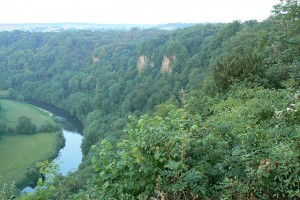 Symonds Yat Rock overlooks the Forest of Dean, Coppett Hill and Wye Valley. The immediate landscape is of the River Wye which winds its way through the gorge.
Symonds Yat Rock overlooks the Forest of Dean, Coppett Hill and Wye Valley. The immediate landscape is of the River Wye which winds its way through the gorge.
The rock is the perfect viewpoint to see the nesting peregrine falcons who set up home every year (roughly April to August). Other birds such as buzzards, goshawks and hobbies are also regularly seen, it is occasionally possible to see migrant raptors such as ospreys and European honey buzzards.
From Symonds Yat Rock there are marked trails linking to the many meandering woodland and riverside walks. Some of these walks can be quite remote so prepare food, water and suitable clothing for the time of year. Phone reception can be very weak and often non existent but the woodland paths are tranquil with stunning scenery.
A hill fort was built here around 2,500 years ago. The site is now a scheduled ancient monument. Refreshments are provided by the 1950s built log cabin cafe. Contact 01594 834479 for more details and opening times.
A scene from the movie Shadowlands was filmed at Symonds Yat Rock, and it was used as a location for some episodes of Series 5 of the BBC television drama Merlin. Another piece of movie trivia… Symonds Yat was used as a location for some of the shots filmed in Harry Potter and the Deathly Hallows – Part 1.
There are several routes up to the Rock from the Saracen’s Head Inn.
There are demanding routes which offer steep and direct access, whereas the more gradual sloped trails take much longer and are further downstream. It’s advisable to take a good map and compass.
The Sculpture Trail
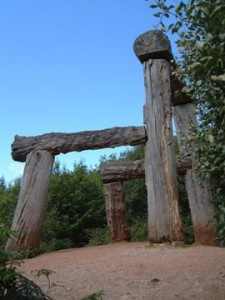 A few minutes drive from Symonds Yat is the Forest of Dean Sculpture Trail. Established in 1986, this four mile long Sculpture Trail was one of the first to open in the UK. The Trail features sculptures created by artists to interpret the Forest environment and the history of this very unusual landscape.
A few minutes drive from Symonds Yat is the Forest of Dean Sculpture Trail. Established in 1986, this four mile long Sculpture Trail was one of the first to open in the UK. The Trail features sculptures created by artists to interpret the Forest environment and the history of this very unusual landscape.
It provides a unique opportunity to walk through the woodlands and discover art along the way. Perfect for all ages and abilities, you don’t need to know about art to enjoy what you see.
The sculptures are installed within the woodland to encourage you to seek them out – the posts with blue rings will direct you – but if you want to make life easier for yourself, pick up a map at Connections at Beechenhurst.
Capability Brown would probably describe the artworks as ‘punctuation marks in the landscape’. Pause for thought and consider – what inspired the artists and what story does the sculpture tell? If you want to know more, visit www.forestofdean-sculpture.org.uk, where you will find information about all of the artists and the artworks.
The sculptures are commissioned by The Forest of Dean Sculpture Trust, a charitable organisation, working closely with the Forestry Commission. The Trust relies entirely on fundraising in order to commission the sculptures for the Trail. If you would like to contribute to future works, or towards maintenance of one of your favourite sculptures, please visit the website.
Other Useful Links
Easy Walks of The Wye Valley & Forest of Dean

